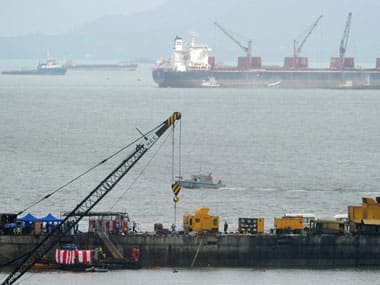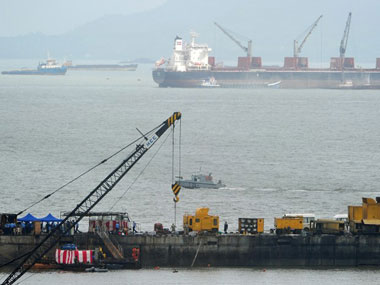The INS Sindhurakshak, which sank on 14 August following a series of explosions and a ravaging fire, had cost India a total of 270 million dollars after an expensive midlife upgrade in Russia last year. Now that India is left with just 13 submarines and only 7 or 8 are available for war time duties, India’s undersea warfare capability is severely dented vis-a-vis the China-Pakistan threat. In what might be a good news for the Navy, India is negotiating with Russia for taking on lease another nuclear submarine. If all goes well, India should have another nuclear submarine in its naval fleet within a year, or even earlier. Indians and Russians have been talking about this for some time. Incidentally, the idea of acquiring another nuclear submarine on lease from Russia predated the Sindhurakshak disaster. But the loss of Sindhurakshak has added much-needed momentum in the Indian defence establishment so much so that the zealots in South Block have already christened the potential acquisition as INS Chakra III. [caption id=“attachment_1065621” align=“alignleft” width=“380”]
 AFP.[/caption] The issue is likely to come up for a formal discussion when Indian Defence Secretary RK Mathur visits Moscow on 1 September. Mathur will be leading a tri-service delegation to Moscow for the next round of meetings of the High Level Monitoring Group on Defence. Many other issues like the Fifth Generation Fighter Aircraft (FGFA) and progress of INS Vikramaditya undergoing final trials in Russia will also be on the agenda, the second nuclear submarine lease issue may well be the main pivot of his talking points with his Russian interlocutors. Indian officials are understandably keeping mum on this highly sensitive issue and that is why there has been no on-record statement to this effect by any minister or senior official thus far. But this may change soon. The Indians have got positive vibes from Russia. It will be a win-win situation for the tried and tested strategic partners of decades. While for India a second nuclear submarine will plug a gaping hole in the Indian naval armour and allow it to safeguard its eastern and western coasts far more effectively, for Russians it will bring huge amount of cash. No other country can fill in the large strategic vacuum that the Indian undersea warfare capability is facing right now. Russia is the only country that India can turn to in times of such dire needs. The Indian engagement with the Russian interlocutors is all set to be focused on this very subject in the coming weeks and months. If the Indian Defence Secretary’s talks with his Russian interlocutors next week move in a positive direction – which is expected – then there are good chances that the matter may come up for final approval of the top leadership of the two countries. India and Russia will have three big occasions in September and October, if RK Mathur’s talks in Moscow yield positive results. First Prime Minister Manmohan Singh and Russian President Vladimir Putin will be meeting in St Petersburg on the sidelines of the G20 summit (5-6 September). Then in October Defence Minister AK Antony will be co-chairing with his Russian counterpart the next meeting of the Indo Russian Inter Governmental Commission – Military and Technical Collaboration (IRIGC-MTC), followed by the 14th Indo-Russian annual summit – both events to be held in Moscow. Apart from very close and warm politico-defence ties between India and Russia, India’s experience of acquiring a nuclear submarine on lease from Russia is a quarter century old when the Russians had leased a nuclear submarine (christened INS Chakra) to India. At that time in 1988, the lease was for three years. The second instance of Russia leasing a nuclear submarine to India came about in 2011and INS Chakra was inducted into the Indian Navy last year. This time the lease is for a period of ten years and the cost is one billion dollars. The INS Chakra III lease negotiations, also for a period of ten years, however, face a stumbling block on cost issues. The Russians this time may not be willing for a billion dollar lease value. The Indians may suggest to the Russians, if they haven’t done so already, to not to peg the costs on dollar terms. Instead the Indian argument could be for pushing a Rupee-Rouble arrangement. But the problem here is that both the currencies are currently battered and bruised by the greenback. Leasing of nuclear submarines for Indian Navy has thus far been a monopoly for the Russians as no other nation has agreed to do so. But then it remains a top secret whether India approached any other Western country like the United States, France or the UK in this regard in the first place. Considering the fact that India’s relations with the above-mentioned Western countries have peaked substantially over the past few years, it should no longer be a mission impossible. Now a days when the Americans have started offering transfer of technology to India for selling their expensive but state-of-the-art defence equipment, leasing a nuclear submarine should no longer be a taboo for them. If that were to happen, India will be spoilt for choice and the Russians would be forced to scale down their prices. But then this is too premature a stage to discuss these things. The writer is a Firstpost columnist and a strategic analyst. His Twitter handle is @Kishkindha.
AFP.[/caption] The issue is likely to come up for a formal discussion when Indian Defence Secretary RK Mathur visits Moscow on 1 September. Mathur will be leading a tri-service delegation to Moscow for the next round of meetings of the High Level Monitoring Group on Defence. Many other issues like the Fifth Generation Fighter Aircraft (FGFA) and progress of INS Vikramaditya undergoing final trials in Russia will also be on the agenda, the second nuclear submarine lease issue may well be the main pivot of his talking points with his Russian interlocutors. Indian officials are understandably keeping mum on this highly sensitive issue and that is why there has been no on-record statement to this effect by any minister or senior official thus far. But this may change soon. The Indians have got positive vibes from Russia. It will be a win-win situation for the tried and tested strategic partners of decades. While for India a second nuclear submarine will plug a gaping hole in the Indian naval armour and allow it to safeguard its eastern and western coasts far more effectively, for Russians it will bring huge amount of cash. No other country can fill in the large strategic vacuum that the Indian undersea warfare capability is facing right now. Russia is the only country that India can turn to in times of such dire needs. The Indian engagement with the Russian interlocutors is all set to be focused on this very subject in the coming weeks and months. If the Indian Defence Secretary’s talks with his Russian interlocutors next week move in a positive direction – which is expected – then there are good chances that the matter may come up for final approval of the top leadership of the two countries. India and Russia will have three big occasions in September and October, if RK Mathur’s talks in Moscow yield positive results. First Prime Minister Manmohan Singh and Russian President Vladimir Putin will be meeting in St Petersburg on the sidelines of the G20 summit (5-6 September). Then in October Defence Minister AK Antony will be co-chairing with his Russian counterpart the next meeting of the Indo Russian Inter Governmental Commission – Military and Technical Collaboration (IRIGC-MTC), followed by the 14th Indo-Russian annual summit – both events to be held in Moscow. Apart from very close and warm politico-defence ties between India and Russia, India’s experience of acquiring a nuclear submarine on lease from Russia is a quarter century old when the Russians had leased a nuclear submarine (christened INS Chakra) to India. At that time in 1988, the lease was for three years. The second instance of Russia leasing a nuclear submarine to India came about in 2011and INS Chakra was inducted into the Indian Navy last year. This time the lease is for a period of ten years and the cost is one billion dollars. The INS Chakra III lease negotiations, also for a period of ten years, however, face a stumbling block on cost issues. The Russians this time may not be willing for a billion dollar lease value. The Indians may suggest to the Russians, if they haven’t done so already, to not to peg the costs on dollar terms. Instead the Indian argument could be for pushing a Rupee-Rouble arrangement. But the problem here is that both the currencies are currently battered and bruised by the greenback. Leasing of nuclear submarines for Indian Navy has thus far been a monopoly for the Russians as no other nation has agreed to do so. But then it remains a top secret whether India approached any other Western country like the United States, France or the UK in this regard in the first place. Considering the fact that India’s relations with the above-mentioned Western countries have peaked substantially over the past few years, it should no longer be a mission impossible. Now a days when the Americans have started offering transfer of technology to India for selling their expensive but state-of-the-art defence equipment, leasing a nuclear submarine should no longer be a taboo for them. If that were to happen, India will be spoilt for choice and the Russians would be forced to scale down their prices. But then this is too premature a stage to discuss these things. The writer is a Firstpost columnist and a strategic analyst. His Twitter handle is @Kishkindha.
Consulting Editor, First Post. Strategic analyst. Political commentator. Twitter handle @Kishkindha.
)